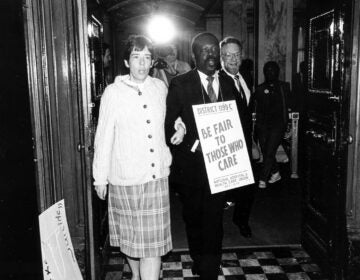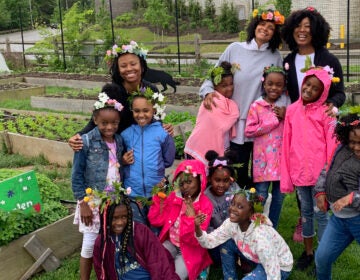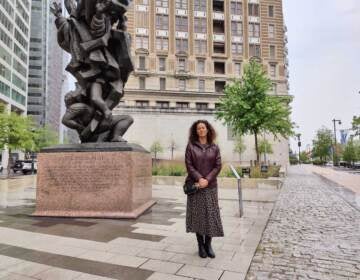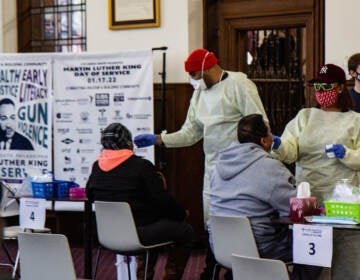Teenagers who desegregated Girard College to be honored with a mural
Teenagers were “the muscle” behind Cecil B. Moore’s historic protest outside Girard College in 1965. The school will soon have a mural depicting them.

An artist's rendering of the Freedom Fighters mural at Girard College. (Courtesy of Mural Arts Philadelphia)
A new mural will be painted at Girard College in North Philadelphia, honoring the students who fought to desegregate it in 1965.
This historic protest was the longest sustained civil rights action in Philadelphia history, lasting seven months and 17 days, led by lawyer and activist Cecil B. Moore.
However the mural will not be honoring the leader of the protest, rather the teenagers who carried it out.
“When Cecil B. Moore put the call out that the walls were going to come tumbling down, many of us had never been involved with the civil rights movement,” remembered Karen Asper Jordan, who was just 16 at the time. “He used to call us his ‘young militants.’”
Girard College was built from the estate of Stephen Girard in 1848, as a boarding school for white, orphaned boys. After the 1954 Brown vs. Board of Education Supreme Court decision, Girard was ordered to desegregate, but by 1965 it still had not done so.
Starting in May 1965, Moore mobilized hundreds of people from all walks of life, including students, professionals, children, adults, even neighborhood gang members, to engage in the prolonged picket outside the walls of the school.
“What made people want to follow him, was that with Cecil you didn’t have to wait years to see the fruits of your activism,” Asper Jordan said. “He believed in direct action. Cecil felt if somebody hit you, you hit back. He was fearless.”
Even Martin Luther King Jr., joined the protest that summer to give a speech. For Asper Jordan and about a dozen of her friends — called the Philadelphia Freedom Fighters — the Girard College protest was a daily job.
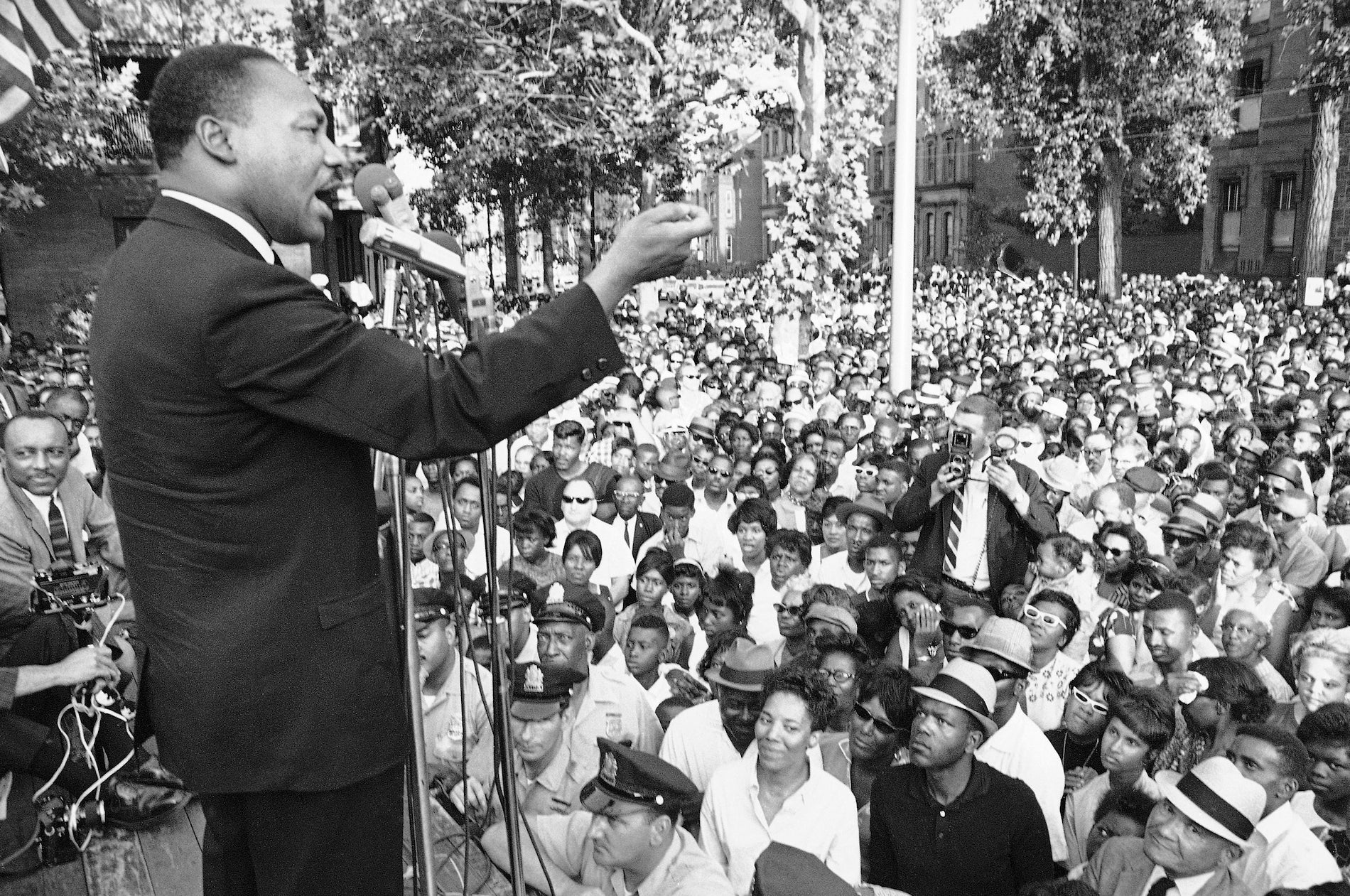
“I went to Simon Gratz at the time,” she said, referring to the North Philadelphia public high school, which is now a charter school. “I would get off the 15 trolley and demonstrate, then go home and do my homework.”
“We formed a little family. We learned freedom songs that pumped you up. It was fun. We were children,” she said.
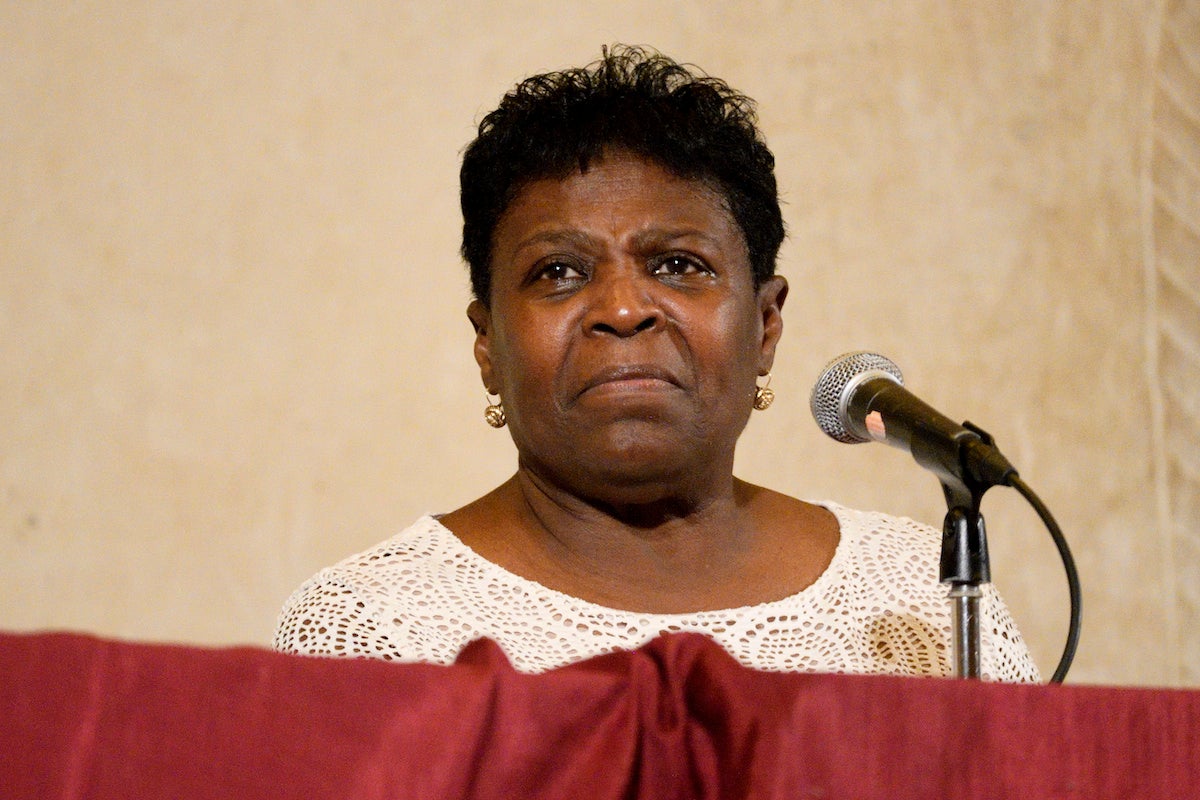
Asper Jordan approached Mural Arts Philadelphia to consider a public artwork about the Philadelphia Freedom Fighters at Girard College. Next month, work will begin to paint a mural on a large building towering over the perimeter wall, about 30 feet by 60 feet.
The image, designed by artists Felix St. Fort and Gabe Tiberino, will feature recreations of archival photos of the young protesters at Girard, with their leader Cecil B. Moore in the background.
“The way I see it, we could not have had this movement without Cecil B. Moore, but he could not have done it without this group of people,” Tiberino said. “When I look back in history, it’s always the young people that really push stuff forward. Even though Cecil B. Moore may have been the brains behind the whole thing, he needed the muscle.”
Although Asper Jordan remembers the Girard protests as a time of meeting lots of new people and of feeling a collective urgency to make a change in the world, it was not all fun and songs. The police response to the demonstrations was led by then-Deputy Commissioner Frank Rizzo, whose tactics – tough and many say racist – would ultimately make him mayor less than 10 years later.
Asper Jordan remembers police Jeeps would be parked with their rear exhaust pipes pointed toward the demonstrators, in an attempt to gas them. She recalls seeing a friend – just 14 years old – attacked by a police dog and then arrested.
“A lot of us watched TV of brutality down South. You would think that’s where it happened,” Asper Jordan said. “But people were being brutalized here.”
After the long period of protest at Girard College ended in December of that year, the Freedom Fighters stayed with Moore, waiting for his signal. When Moore fought against slum landlords forcing tenants to live in substandard apartments, or store owners cheating customers, even the Vietnam War, he needed his foot soldiers to show up.
“If anything was going on in the city, we were all there,” Asper Jordan said. “Somebody would make a phone call, the young militants were there.”
After Moore died in 1979 while serving as a city councilmember, the Freedom Fighters continued his legacy of direct action. Even while working as a nurse with Jefferson Hospital for 41 years – she retired three years ago – Asper Jordan kept doing activist work. Of the roughly 12 core members of the Fighters, she said there are seven still living.
The mural honoring the Freedom Fighters is expected to be finished in early summer. It will feature a design pattern of adinkras, West African symbols associated with the Akan people of what is now Ghana and Côte d’Ivoire. Each adinkra symbol has its own distinct meaning: hope, sanctity, strength, service, etc.
“They have a cool stylish design to them,” Tiberino said. “They use them as patterns in a lot of African art.”
For many of its larger works, Mural Arts Philadelphia normally holds paint days, when neighborhood residents or community members can come to the site and join the painting process, given instructions on what colors to use and where to brush. However, the coronavirus pandemic does not allow for such public gatherings.
Instead, MAP and the artists created painting kits that include a selection of adinkra symbols and three jars of color were sent out to participating community members. The participants paint the symbols however they wish, using the paint provided, and then send them back to the artists.
Tiberino said about 150 adinkra kits went out, and so far almost 100 have been returned. Each surviving member of the Freedom Fighters contributed their own adinkra interpretations. Previously, adinkras had never been part of the Freedom Fighters’ visual protest language.
“This was new to us,” Asper Jordan said. “These symbols reflect our values. They talk to our inner strength, our resolve, our desire, and the lessons we learned from the movement. Knowledge, unity, love, justice, perseverance, excellence, encouragement. This is us. These were the things that surrounded us while we were demonstrating.”

Get daily updates from WHYY News!
WHYY is your source for fact-based, in-depth journalism and information. As a nonprofit organization, we rely on financial support from readers like you. Please give today.



